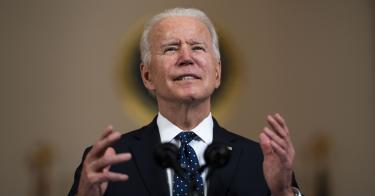The administration is sending mixed signals on nuclear modernization.
The president’s “skinny budget” declares it would maintain “a strong, credible nuclear deterrent for the security of the Nation and U.S. allies.” Yet his Interim National Security Strategy Guidance states: “We will take steps to reduce the role of nuclear weapons in our national security strategy while ensuring our strategic deterrent remains safe, secure, and effective.”
Those “steps” might include cutting the nuclear modernization budget. Deputy Assistant Secretary of Defense Leonor Tomero recently suggested as much, stressing that “some plans are very expensive.”
But reducing the nuclear modernization budget is incompatible with maintaining a “strong, credible nuclear deterrent.” You can’t have it both ways—cuts to modernization programs would likely weaken deterrence in the face of advancing nuclear threats.
>>> Nuclear Modernization Is Our Top Defense Priority, and America Can Afford It
The notion that the U.S. can maintain a strong deterrent while cutting the nuclear modernization budget flies in the face of repeated warnings, most recently voiced by both Vice Chairman of the Joint Chiefs of Staff Gen. John Hyten and Commander of U.S. Strategic Command Adm. Charles Richard, that nuclear modernization is already “late-to-need.”
After years of deferring the recapitalization of nuclear systems, the United States has no choice but to provide the necessary funding or face delays in key delivery schedules. Of course, cost savings based on engineering or manufacturing efficiencies would be welcome, but making reductions that would delay or harm programs for the sake of saving money would ignore the current reality.
To that point, last year former Pentagon acquisition chief Ellen Lord testified that even minor cuts to the Ground Based Strategic Deterrent (GBSD)—the replacement program for intercontinental ballistic missiles—would result in schedule delays.
With nuclear modernization already late-to-need, delays could stick the United States with Cold War capabilities whose deterrence value erodes as they continue to age.
For example, the current Minuteman III missiles are 50 years old and increasingly vulnerable to cyberattack. According to Adm. Richard, “Just to pace the cyber threat alone, GBSD is a necessary step forward.” If adversaries think they can defeat our 400 ICBMs with a cyberattack, doing so may become more attractive.
Our adversaries continue to build nuclear forces, so now is not the time to reduce the role of nuclear weapons and take on these potential risks.
Russia is expected to grow its unconstrained stockpile of tactical nuclear weapons, which already outnumbers the U.S. inventory by 10 to 1. And it’s building entirely new nuclear capabilities.
Meanwhile, China is expected to double—if not triple or quadruple—its nuclear stockpile, and become a peer nuclear competitor with the United States by the end of the decade.
Never before has the United States had to deter two peer adversaries—and deter them differently—at the same time. If anything, the United States should be working tirelessly to strengthen nuclear deterrence, rather than trying to cut down on nuclear modernization as much as possible without weakening national security.
>>> The Increasing Russian Nuclear Threat
And contrary to Ms. Tomero’s claim, nuclear modernization is not expensive. Critics like to quote estimates that nuclear modernization will cost $400 billion. Yes, that’s a lot of money, but it’s spread out over 30 years. Talking about 30-year life-cycle costs when the topic is a one- to five-year budget is highly misleading.
In fact, nuclear modernization costs less than what North Americans will pay for Netflix over the next 30 years. Netflix has about 74 million subscribers in North America who spend, on average, $13.32 per month. Taken over 30 years and adjusted for inflation, that’s more than $500 billion.
While President Biden says he’s committed to both addressing growing global threats and maintaining a strong nuclear deterrent, the budget will ultimately speak louder. A budget that does not fully support modernization at a time when nuclear threats are growing would be nothing less than irresponsible.
This piece originally appeared in The Washington Times




